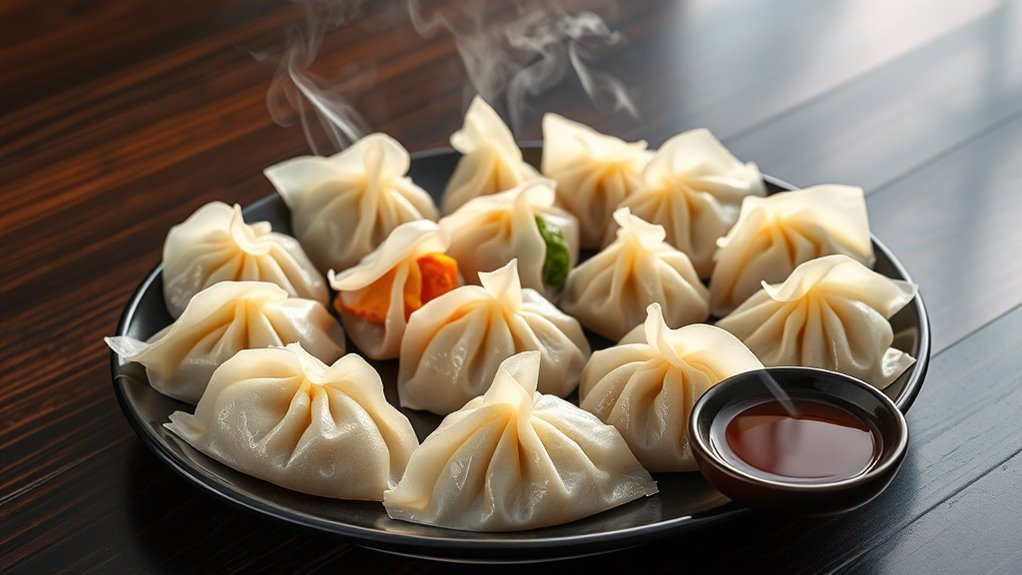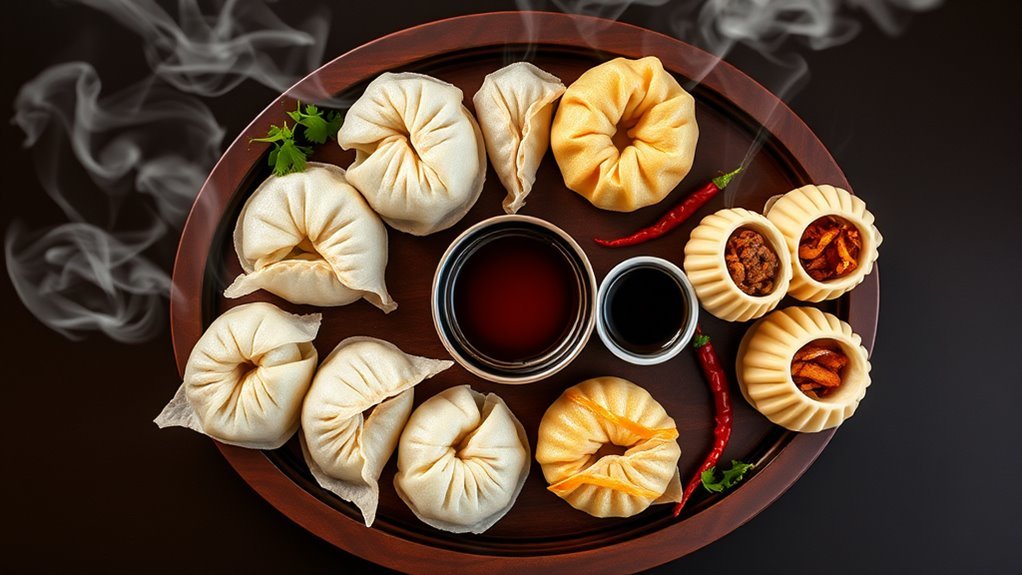Alright folks, gather 'round because we're diving into something a little different today. You know and love your classic dim sum – those delightful little dumplings and buns that have been around for ages. But how about we shake things up a bit? We're talking about a dim sum platter that takes those beloved flavors and gives them a fun twist with some fusion fillings.
Picture this: juicy Korean bulgogi snug inside gyoza wrappers, or some tasty Mediterranean-spiced shumai that'll make your taste buds do a little dance. It's all about combining what we love from different cuisines to create something new and exciting, without losing that comforting vibe of traditional dim sum.
So, if you're ready to impress your friends or family at your next gathering, let's roll up our sleeves and get cooking. This isn't just food; it's an adventure on a platter! Let's explore these creative combinations together and whip up some modern masterpieces that'll leave everyone craving more.
Ingredients

Traditional dim sum platters showcase a diverse array of ingredients carefully selected for their complementary textures and flavors. At the heart of most dim sum offerings are proteins like prawns, ground pork, and chicken, which are enhanced with aromatic seasonings including garlic, ginger, and soy sauce. These proteins are often combined with starchy components such as tapioca starch and potato flour, which provide the characteristic chewy texture in wrappers and help bind the fillings together. The mixture requires careful preparation, with prawns needing to be combined with ingredients and rinsed for hours to achieve the perfect consistency.
The seasoning profile of dim sum relies heavily on umami-rich ingredients like oyster sauce and sesame oil, while vegetable elements such as bamboo shoots, Chinese chives, and mushrooms add textural contrast and nutritional value. Modern fusion interpretations have expanded the traditional ingredient list to include innovative additions like caviar tobiko for garnish, fresh citrus elements, and alternative proteins such as tofu for vegan variations, all while maintaining the essence of classic dim sum preparations.
| Category | Common Ingredients |
|---|---|
| Proteins | Prawns, Ground Pork, Chicken, Tofu |
| Starches | Tapioca Starch, Potato Flour, Wonton Wrappers |
| Vegetables | Bamboo Shoots, Chinese Chives, Mushrooms, Carrots |
| Seasonings | Soy Sauce, Oyster Sauce, Sesame Oil, Ginger, Garlic |
| Aromatics | Rice Wine Vinegar, Chili Paste, Black Pepper |
| Garnishes | Wolfberries, Fried Shallots, Green Onions |
Recipe

A dim sum platter represents a traditional Chinese dining experience featuring an assortment of small, bite-sized portions served in steamer baskets or small plates. This collection typically includes various dumplings, buns, rolls, and other savory items, offering diners a diverse range of textures, flavors, and cooking techniques. The filling of dumplings combines shrimp with tofu, creating a delicate yet satisfying texture.
The key to creating a successful dim sum platter lies in the balance of different items, incorporating steamed dumplings like har gau and siu mai, baked items like char siu bao, and fried elements such as spring rolls. Each component requires specific preparation techniques and timing to guarantee all items remain at peak serving temperature.
| Ingredient | Amount | Notes |
|---|---|---|
| Dumpling wrappers | 40 pieces | Store-bought or homemade |
| Ground pork | 500g | 20% fat content |
| Shrimp | 300g | Peeled and deveined |
| Chinese mushrooms | 100g | Soaked and finely chopped |
| Bamboo shoots | 100g | Finely diced |
| Green onions | 4 stalks | Finely chopped |
| Ginger | 30g | Minced |
| Soy sauce | 3 tbsp | Light soy sauce |
| Sesame oil | 2 tbsp | For seasoning |
| White pepper | 1 tsp | Ground |
| Salt | 1 tsp | To taste |
| Cornstarch | 2 tbsp | For binding |
Begin by preparing the fillings for different items: mix ground pork with chopped mushrooms, bamboo shoots, and seasonings for siu mai; combine chopped shrimp with bamboo shoots and ginger for har gau; and prepare other fillings as needed. Shape each item according to its traditional form – pleated dumplings for har gau, open-faced siu mai, and sealed buns for char siu bao. Steam items in batches, starting with the ones that take longest to cook, typically 8-10 minutes for dumplings and 12-15 minutes for buns. Arrange on serving platters with appropriate dipping sauces and garnishes.
When preparing a dim sum platter, timing is essential as different items require different cooking times and methods. Prepare all fillings in advance and keep them chilled. Have multiple steamers ready to cook different items simultaneously. Confirm wrapper edges are properly sealed to prevent filling leakage during steaming. Keep cooked items covered with a damp cloth to prevent drying while preparing remaining items. Serve immediately once all components are ready, as dim sum items are best enjoyed hot and fresh.
Cooking Tips

While mastering dim sum may seem challenging at first, we'll help you perfect these delicate bites with expert tips that focus on four key areas: meat handling, aromatics, vegetable preparation, and wrapping techniques.
For juicy, tender fillings, we'll throw the meat mixture repeatedly into the bowl while gradually adding liquid in one direction. Don't forget to incorporate egg whites and meat aspic for that perfect texture. Stirring and throwing the filling for 5 to 8 minutes develops the optimal texture.
We're also big fans of using chicken thigh instead of breast meat – it's much more forgiving and stays moist.
Remember to salt your vegetables ahead of time and grate those aromatics finely.
When wrapping, three pleats per side will give you that classic look.
History

These delightful bites we acknowledge as dim sum have traveled through centuries of Chinese history to reach our plates today.
From its origins in the Song Dynasty's imperial kitchens to bustling teahouses along the Silk Road, dim sum has evolved into the cherished tradition we recognize today. Early American restaurants like the Hang Ah Tea Room helped establish dim sum's presence in the United States.
- Started as royal delicacies with pheasant and steamed milk treats
- Name means "touch the heart" in Chinese – perfectly capturing its appeal
- Flourished in Guangzhou's teahouses with the "one cup, two pieces" tradition
- Gained diversity through Mongol influences in the 13th century
- Blossomed into distinct regional styles like Cantonese, Shanghai, and Sichuan varieties
Final Thoughts

Modern innovations have transformed dim sum from its ancient roots into an exciting world of culinary fusion and creativity.
We're seeing incredible combinations like Italian-Mexican influences, sushi-inspired rolls, and even plant-based alternatives that honor tradition while embracing change. This platter serves 6 people with its generous portions, making it perfect for family-style dining and social gatherings.
The possibilities seem endless, from artistic presentations that dazzle on social media to luxurious ingredients like truffles and foie gras.
Whether you're a dim sum purist or an adventurous foodie, there's never been a more thrilling time to explore these delectable bites.
We can't wait to see what creative directions dim sum will take next!
Conclusion
So there you have it, folks – a dim sum platter with a twist! This isn't just your grandma's dim sum; it's a delightful fusion that pays homage to tradition while inviting new flavors to the party. Remember, cooking is all about having fun and experimenting, so don't be shy about trying out different fillings that reflect your own tastes. Whether you stick to the classics or jazz it up with something a little zany, the important thing is to gather your friends and family around the table, share some laughs, and enjoy the fruits of your labor. Now, roll up those sleeves and get ready to impress – your dim sum adventure is just beginning!

